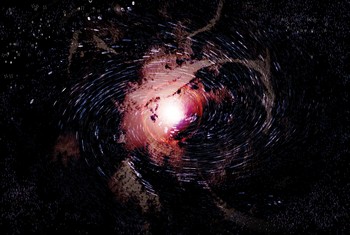 |
Seeing red in distant galaxies
To an astronomer, color is just as important as it is to an interior designer--though in quite a different way. To both, what the eye perceives as red is light of relatively long wavelength; the wavelength of the light the eye perceives as blue is relatively short.
|
The Extravagant Universe: Exploring Stars, Dark Energy and the Accelerating Cosmos
In February 1998 new observations of exploding stars in distant galaxies stood the world of cosmology on its ear. The expansion of the universe, far from slowing down, as earlier theories had implied it should, turned out to be speeding up. Objects in the universe are moving apart from one another at progressively greater, speeds. The new findings foretell a future in which the cosmos becomes an unimaginably vast, cold, dead, and barren expanse of near-nothingness. |
Bolts from beyond: "shooting stars" secrets
For two centuries, astronomers and geologists have recognized that the Earth is continually bombarded by small extraterrestrial objects called meteoroids. Each piece of this cosmic debris has its own orbit around the Sun. Because some of those orbits cross the Earth's, our planet and certain bits of the debris inevitably reach the same point at the same time and collide.
Made of atomic size stars in a clumpy firework Universe
The discoveries of normal galaxies, strings of galaxies and heavy elements in the far distant universe [1-7] suggest that these space objects have to be older than what the big bang universe can allow for their creation. In this way the big bang universe enters its current age crisis [8], which will require some new assumptions to mend the edifice of this complex theory.
Black Holes
Black holes are probably the most fascinating (theoretical) objects in astronomy. Such objects, which scientists believe must exist, would account for the spin-rate of our galaxy, which cannot be explained by the combined mass of the visible stars. But exactly what are black holes?
The Total Solar Eclipse
Astronomer Johannes Kepler did not have the benefit of sophisticated telescopes or computers yet, in the 17th century, he was able to establish a proven harmonic relationship between the planets. In his third law of planetary motion Kepler states: The orbital period of a planet is proportional to its distance to the Sun This was first revealed in his seminal work Harmonice Mundi or 'Harmony of the World' in 1619. It is also known as the Harmonic Law.
Seeing Doubles - Brief Article
At some time or other, you've probably found yourself staring up at the stars and marveling, "Look at all those points of light!" Maybe for emphasis you added an adjective: "Look at all those individual points of light!" If so, you were wrong.
Nebulous categories: the many species of galaxies turn out to be close kin
Two and a half centuries ago, before the English astronomer Sir William Herschel built the world's first seriously large telescope, the known universe was little more than the stars, the planets, the Sun and Moon, and the Galaxy, forming a milky band across the night sky. Indeed, the word "galaxy" derives from the Greek galaktos, or milk. The sky also held the nebulae--fuzzy, indeterminate objects such as the Andromeda nebula, which lives among the stars of the constellation Andromeda. |




